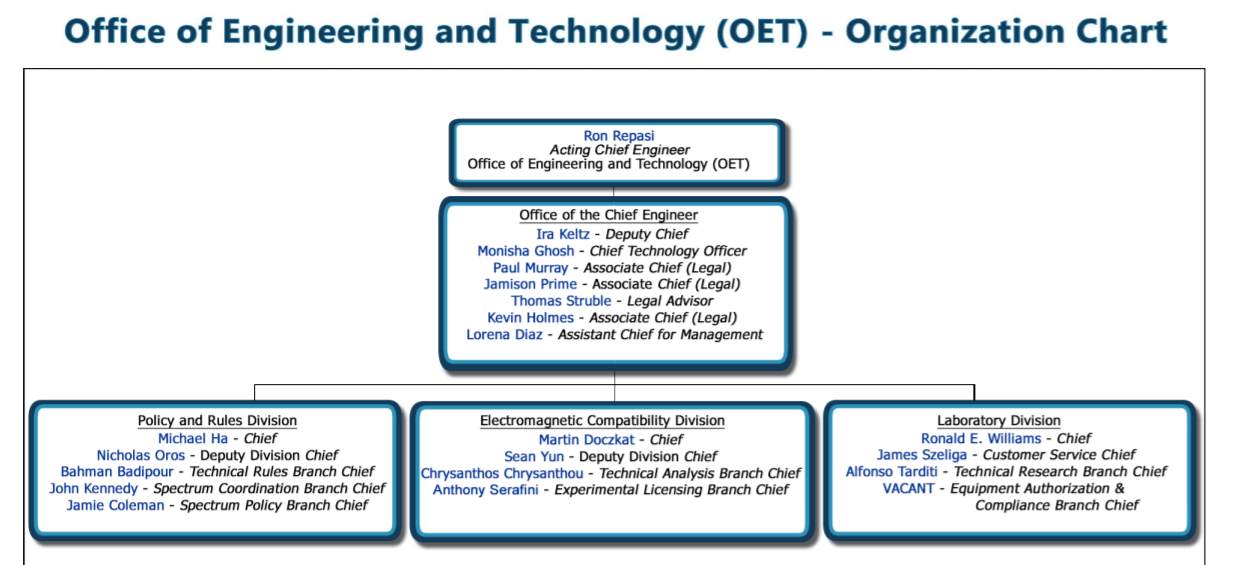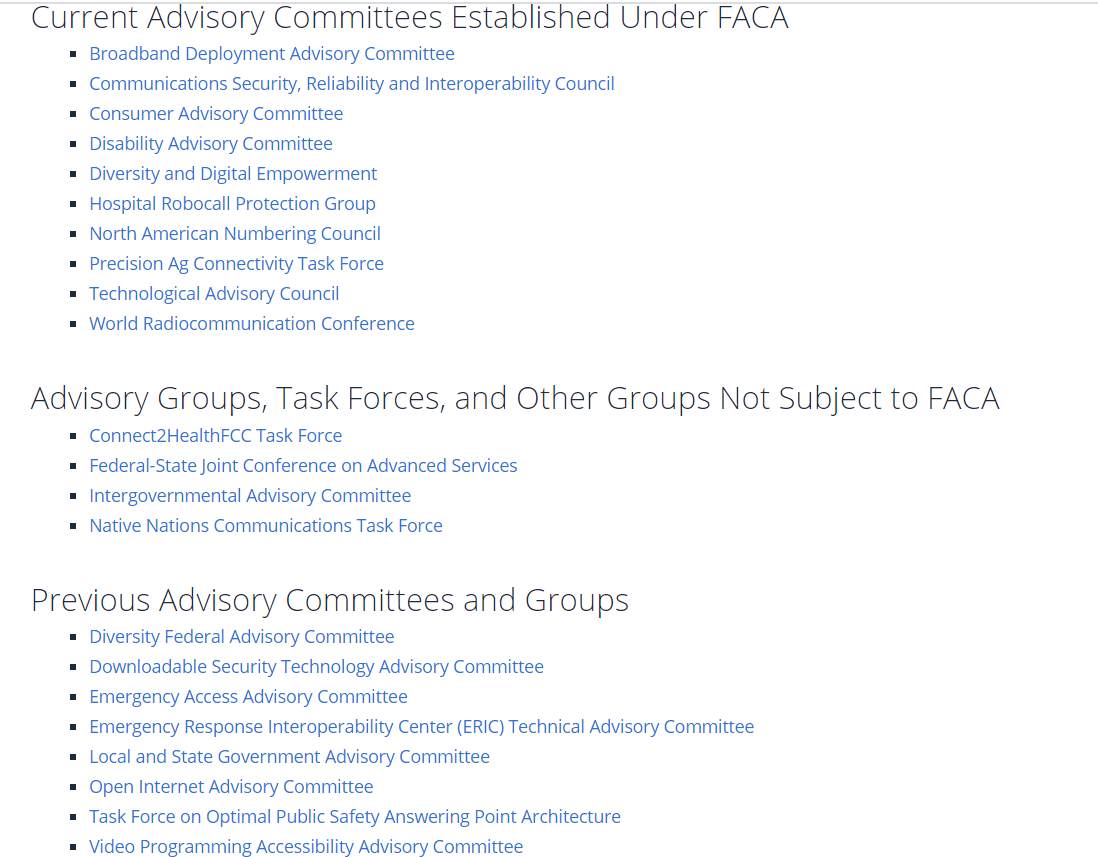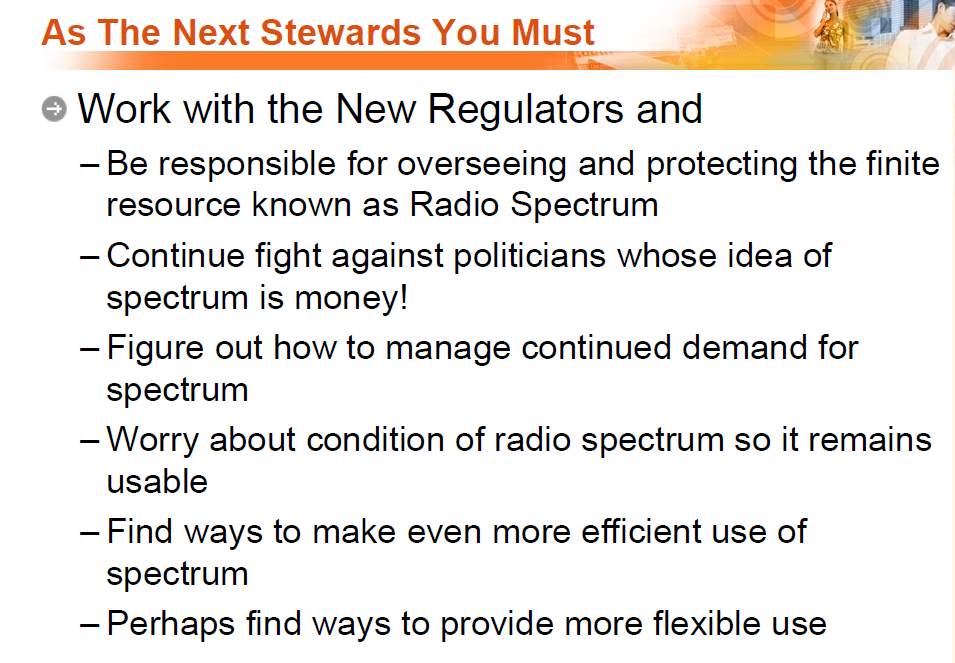The Federal Communications Commission’s (FCC) mission statement as presented on its web page under the “About the FCC” tab reads as follows:
“The Federal Communications Commission regulates interstate and international communications by radio, television, wire, satellite, and cable in all 50 states, the District of Columbia and U.S. territories. An independent U.S. government agency overseen by Congress, the Commission is the federal agency responsible for implementing and enforcing America’s communications law and regulations.”

My question: Have the three current majority commissioners been pursuing this mission? I don’t think so considering their willingness to favor vendors of broadband services and vendors that provide devices for unlicensed wireless services. This has led to a lack of regard for critical-communications users and those in rural areas who truly need access to broadband services.
Spectrum is a finite resource. We cannot make more of it so we need to be aware of how it is used for what purposes. The FCC is managed by five commissioners. Three are from the party of the sitting President and two are from the other party. Until January 20, 2021, this means the FCC Chairman and two other commissioners are from the Republican party and two are from the Democratic party. Since changes are coming at the White House, this is the time to start planning for changes that are needed at the FCC and in the way of how spectrum is being used and abused.
Radio Spectrum
There is more demand for radio spectrum than there is spectrum available, even with advances being made by astute radio engineers. When managing spectrum, it is imperative to avoid causing interference between systems, and when allocating spectrum, caution needs to be taken to avoid raising the noise floor. It does not appear the FCC has given consideration to either of these before moving forward. When measuring the noise floor with very sensitive test equipment at the radio test range at the Idaho National Labs, we find it to be very low due to the lack of spectrum usage in the area.
When measuring the noise floor in any given portion of spectrum in any major city in the United States, we find the noise floor to be considerably higher. As the noise floor increases, systems in that spectrum begin to degrade because the receivers don’t hear radio signals as well as they did. This is one reason WiFi range has deteriorated from when you first installed your WiFi access point using 2.4-GHz spectrum three or four years ago. Most people simply add more access points to reach a higher level of coverage, but doing so also raises the noise floor in the 2.4-GHz and 5.8-GHz bands. Thus, it becomes a never-ending battle to maintain your initial WiFi coverage within your house or office.
Part of the problem is that the current FCC Office of Engineering and Technology (OET) is led predominantly by legal specialists rather than engineering specialists. Chief Technology Officer Monisha Ghosh is well degreed and well versed in radio technologies, which is a plus. However, most of her staff are from the legal world, which seems to be favored at the FCC. There are three groups under the Office of the Chief Engineer as depicted in the organization chart below. It does appear that there is a fair amount of radio technology expertise available should the FCC Commissioners decide to tap this talent when faced with spectrum issues.

From the outside looking in, it appears the majority of the FCC Commissioners do not seek direction from the Office of the Chief Engineer. It is clear that past FCCs had a much stronger reliance on people with vast amounts of RF and spectrum experience, tests, and evaluations.
Many who regularly read this column know I have been critical of the current FCC and its actions, but they also know I praise the FCC when it does something I believe to be beneficial. Unfortunately, the majority of today’s commissioners appear to be all about following the money. They seem to bend over backward to expedite additional spectrum for commercial purposes and increasing unlicensed access, which is driven by vendors that build and sell equipment for unlicensed systems. Those who provide critical communications, government agencies, utilities, and enterprises have been left out.
The Past Four Years
For the past four years, we have watched as the FCC has opened up the 6-GHz band, which is heavily used for critical-communications point-to-point microwave, to unlicensed WiFi 6 users. Theoretically, an automated system will assign frequency segments that will not cause interference to existing microwave systems, but this remains to be proven in the real world.
Next, for a number of years, this FCC has mucked around with the 50 MHz of 4.9-GHz spectrum that has been reserved for public-safety communications since 2002. Without any solid statistics, the current FCC decided this spectrum is underutilized and has reallocated it to the states for their use and to lease it out. The FCC contends existing public-safety users will be protected, but so far there is nothing definitive that would ensure the necessary grandfathered protection. Timing of this takeaway is interesting in that the public-safety community is adopting broadband technologies for its field operations at a furious pace. It is clear it will need more broadband spectrum in the future, yet it appears critical communications are not on the minds of three FCC Commissioners.
Even after the Department of Defense (DOD), the Federal Aviation Administration (FAA), and others objected to this network, the FCC recently approved of Ligado building and operating a terrestrial Internet of Things (IoT) network on spectrum used for satellite communications. Ligado’s new network spectrum is too close to spectrum where millions of GPS receivers are located, potentially introducing interference with location services.
This FCC is also considering dividing up the 5.9-GHz band that is used for collision avoidance and other vehicular uses. It feels this spectrum allocation could be cut in half and the other half, once again, could be become unlicensed spectrum.
There are other items the current FCC Commissioners have undertaken without considering the possible repercussions. These three FCC Commissioners are most likely preparing to exit stage left, leaving behind spectrum issues that may prove detrimental to users.
The National Telecommunications and Information Administration (NTIA) is also charged with spectrum allocations. The NTIA is part of the Department of Commerce (DOC) and oversees spectrum used by federal agencies. Over the past decade, the NTIA and the FCC have worked together to “find” spectrum that can be converted from federal to non-federal use or, in some cases, allocated on a shared basis. However, there remains more demand for spectrum than there is spectrum available. There needs to be a balance between serving the public’s growing thirst for more spectrum and what the critical-communications community needs today and into the future, all with an eye on keeping spectrum free from interference.
Rural Broadband
This FCC has bungled mapping where broadband is and is not available in the United States. While the FCC has been putting funds into rural broadband, it has not done so in a cohesive manner, and it is not providing funds to help operate broadband networks once they are operational. The largest single pool of funds is the $9 Billion allocated by the FCC to be used exclusively for deploying 5G and it is providing funding to existing broadband operators that want to expand their 5G deployments. However, there are many other ways wireless can be deployed using a mix of available technologies.
Obviously, 5G is today’s hot topic, but the 5G to be deployed in rural areas is mostly low-band 600/700 MHz with speeds only somewhat better than LTE. I expect some mid-band 5G with better than low-band data rates will be deployed, but other wireless technologies should also be considered. In addition to funding for 5G, the current FCC issued a number of licenses to tribal nations in the 2.5-GHz band. This is a good move, but only one network currently provides 5G devices and equipment on 2.5 GHz while tribal nations need broadband for their public-safety personnel and to communicate with outside first-responder agencies that are called on for assistance, which is what FirstNet is all about.
FCC Advisory Groups and Committees
You will see on its website that the current FCC has a number of advisory groups and committees. The list of ongoing committees is impressive but nowhere in this list will you find a committee or group focused on critical communications. In the list of previous advisory groups, you will see that former FCCs had committees to gather input from critical-communications users and vendors. I served on the Emergency Response Interoperability Center (ERIC) Technical Advisory Committee representing the National Sheriffs Association (NSA) and many people involved in public-safety communications had served on a variety of committees.
When the issue of public-safety interoperability was first raised, the FCC established a number of committees to assist with spectrum allocations, leading to the FCC’s authorization of additional spectrum for public safety in the 4.9-GHz and 700-MHz bands. Today, some 700-MHz spectrum is used for Land Mobile Radio (LMR) and 20 MHz makes up the Band 14 spectrum allocated to The FirstNet Authority for a Nationwide Public-Safety Broadband Network (NPSBN).

What Needs to Be Done
As new FCC Commissioners are nominated and confirmed, I would like to see a number of improvements. I will start by saying I hope Commissioners Rosenworcel and Starks remain on the board. Both have proven they have open minds when it comes to all things spectrum. Commissioner Rosenworcel has been a stanch supporter of closing the digital divide and both voted against the FCC rulemaking to give the 4.9-GHz band to the states to lease out.
If I could select other commissioners, they would have an understanding of spectrum issues rather than legal issues. The FCC is currently overburdened with attorneys while this next decade faces critical spectrum issues. Unfortunately, I foresee more interference issues resembling those we had between Nextel and the 800-MHz public-safety bands, and I see the noise floor for all things radio continuing to increase. Even so, I believe spectrum pollution will be the most significant issue we will face with spectrum allocations. As with our rivers and streams that continue to be polluted by chemicals and other foreign substances that find their way into them, once spectrum pollution reaches a critical point, it will be much more difficult to correct if we don’t manage the spectrum better now.
Some of the tasks I think need to be undertaken soon after the new FCC is settled in include the following:
- If the T-Band repeal bill is not passed by the Senate and signed into law before the new FCC is operational, the new FCC should work with the President and the Senate to pass it into law as soon as possible. For those who are not aware, when Joe Biden was Vice President Biden, he was actively supportive of public-safety’s efforts to move FirstNet legislation through Congress and on to the then-President’s desk for signature. Several meetings between the Public Safety Alliance (PSA) and VP Biden and/or his representatives helped speed acceptance of what public safety needed from Congress.
- Undo the ruling awarding 4.9-GHz spectrum to the states and set up an advisory committee made up of public safety, vendors, and interested parties to work toward better use of the spectrum and full public-safety access.
- Require and review field trials with Wi-Fi 6 in the 6-GHz microwave band and, if unlicensed use is to be approved, pass new rules requiring a way to identify any WiFi 6 device that causes interference to one or more critical-communications microwave system so it can be quickly taken out of service or repaired.
- Rescind the Ligado 5G IoT network authorization and/or require immediate field testing between it and GPS systems to determine if and how much interference is caused by the Ligado network.
- Review Little Low Earth Orbiting (LEO) and other broadband satellites approved for use and, with input from industry experts, develop a long-term set of guidelines for avoiding issues such as spectrum interference and space congestion.
- Work with the NTIA on a long-term spectrum allocation system that includes guardrails between primary and secondary spectrum access.
- Return all 5.9-GHz spectrum to be used for vehicular anti-collision activities.
- Vet every new spectrum allocation with competent radio engineers and field testing if indicated.
- Monitor the noise floor across a broad range of radio spectrum in major metropolitan areas on an annual or bi-annual basis.
I am sure you can think of more suggestions for the new FCC. For my part, I hope those in charge at the Public Safety and Homeland Security Bureau will be well seasoned and will give priority to the interests of critical-communications users. When there is change at the top, it is important for the agencies and the dedicated people overseeing them to remain as stable as possible.
Conclusions
Career public servants at related bureaus and divisions are dedicated to their work and understand the issues facing allocation of spectrum and laws pertaining to spectrum usage. Unfortunately, it appears today’s commissioners have their own agendas for whatever reason and are not listening to comments that come from outside or even inside their organizations.
I hope under new management the FCC can return to being an organization that seeks guidance from experts and those who understand what is required to be a steward of the spectrum. The following is a challenge I made to a group of university engineering students a few years back.

Today and into the future, we have an opportunity to influence the FCC to work on behalf of everyone who wants and needs access to spectrum. Moreover, we need an FCC that understands the “critical” in critical communications means priority in managing spectrum and not accepting spectrum pollution.
Winding Down
Push-To-Talk
Sometimes it appears as though it will be a very long time before full interoperability will be available for the public-safety community. However, many companies are making progress in their quest to provide fully interoperable Push-To-Talk (PTT) on both FirstNet/LTE and LMR public-safety radio systems. Then a press release comes along to let us know things are indeed moving along. Most recently, ESChat announced that its ESChat over-the-top PTT application, certified for use on FirstNet and other LTE broadband networks, is being used by public safety and many federal government agencies.
This press release is two-pronged. First, ESChat has migrated all its public-safety customers to AWS GovCloud. Until now, only federal users had been hosted on the AWS GovCloud. Now all ESChat public-safety users with the cloud model (as opposed to hosting their own ESChat server) are centralized on the GovCloud along with federal users. This is a significant move since now military, federal, state, and local public-safety users can communicate with each other.
The second part of the release concerns ESChat’s completion of its Interworking Function (IWF) to provide secure and fully-interoperable communications between FirstNet/LTE users and existing public-safety LMR systems. ESChat has been providing this type of interconnection for a while, but now it is available for virtually all forms of land mobile radio systems from analog through all the digital versions including DMR as well as P25.
Readers might recall that ESChat had recently announced an agreement with Samsung to add ESChat to certain models of Samsung devices. I commented that since Samsung was providing FirstNet’s (Built with AT&T) Mission-Critical Compliant PTT, I wonder if this relationship will provide a road to full MCPTT/ESChat/LMR interoperability, which I believe to be a must-have. I congratulate ESChat and now I am waiting to see what is coming next for critical-communications push-to-talk, push-to-data, and push-to-video.
Our first responders are still overburdened with fires, hurricanes, the virus, and other issues. While this is taxing our frontline and support people, I am thankful this overload of incidents occurred after FirstNet became operational and a much broader degree of interoperability became available. FirstNet is not yet perfect but we are making great strides. Being an optimist, I look forward to the very near future when no matter which devices first responders carry, they will be able to communicate with any other first responder anywhere in the United States.
Until next week…
Andrew M. Seybold
©2020, Andrew Seybold, Inc.


Be the first to comment on "Public Safety Advocate: Time for Changes at the FCC"